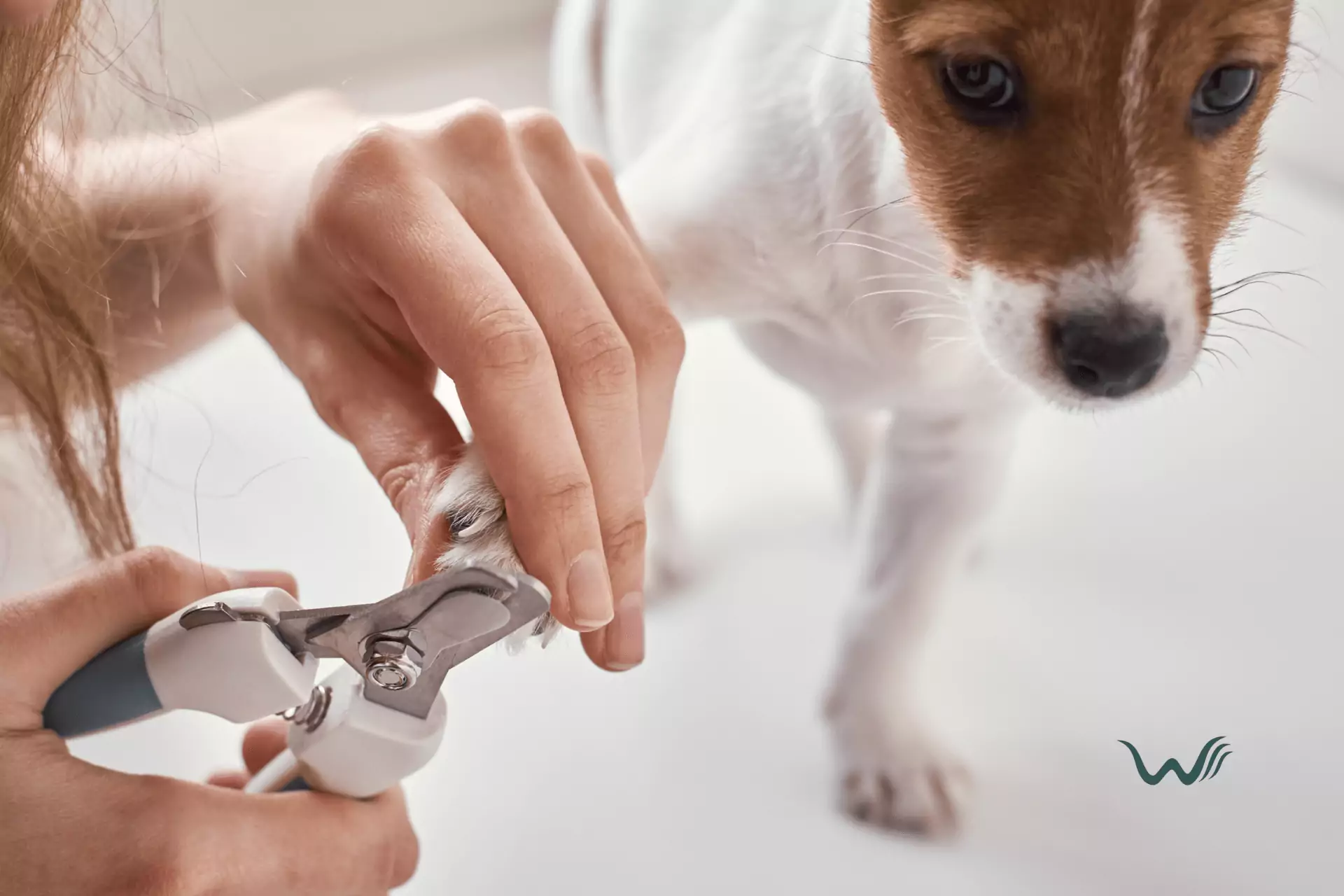

What Causes Blisters On Dogs Paws
by Tayyaba Amir
Last updated: April 8, 2025
Verified and Approved by:
Angela Morris,
MSW, LCSW
Fact Checked

Do you notice your furry friend limping or licking their paws more than usual? It could be a sign of blisters forming on their delicate paw pads. Blisters on dogs’ paws can be caused by various factors, such as rough terrain, hot surfaces, or even certain chemicals. However, trauma and specific injuries also play a significant role in blister formation.
For instance, a dog’s paw pad can develop a blood blister if it gets pinched. This type of blister is filled with blood rather than the usual clear fluid, making it a unique and specific result of direct injury.
Understanding these causes helps pet owners take preventive measures and ensure their furry friends’ paws remain healthy and blister-free. As a responsible pet owner, it’s essential to understand what causes these blisters and how to prevent and treat them to ensure your dog’s comfort and well-being.
By learning about the common causes of blisters on dogs’ paws, you can take proactive steps to protect your canine companion from unnecessary discomfort. Whether it’s adjusting your walking route to avoid abrasive surfaces or investing in protective booties, there are simple ways to prevent blisters from developing in the first place. Stay informed and attentive to your dog’s needs to keep their paws healthy and happy.
Key Takeaways
- Rough terrain can cause blisters on a dog’s paws
- Hot surfaces can lead to blisters on a dog’s paws
- Certain chemicals may also cause blisters on a dog’s paws
- Symptoms of blisters on a dog’s paws include excessive licking, redness, swelling, and changes in gait
Common Causes of Blisters on Dogs’ Paws
Just like hot pavement can burn our feet, the common causes of blisters on dogs’ paws can be as painful as walking on hot coals. Your furry friend might develop blisters from walking on rough surfaces like gravel or concrete for long periods. The constant friction and pressure can lead to irritation and eventually blisters, causing discomfort and pain for your pup.
Additionally, exposure to extreme temperatures can also contribute to blisters on your dog’s paws. Walking on scorching hot pavement during the summer or icy sidewalks in the winter can cause burns or frostbite, leading to blisters forming on their sensitive paw pads. It’s essential to protect your dog’s paws from these harsh conditions to prevent painful blisters and keep them comfortable and happy.
What Causes Blood Blisters on a Dog’s Paws?
Blood blisters on a dog’s paws are typically the result of physical trauma. When a dog’s paw pad is pinched or squeezed, it can lead to the formation of these blisters. This traumatic event causes blood vessels beneath the skin to rupture, creating a pocket of blood.
Common Causes Include:
- Rough Surfaces: Walking or running on abrasive surfaces like gravel or rough concrete can injure a dog’s paw pads.
- Heavy Pressure: Jumping from heights or landing awkwardly can exert excessive force on their feet, leading to blisters.
- Accidents: Being stepped on or caught in tight spots can pinch the skin and trigger blister formation.
Being proactive about examining your dog’s paws regularly can help to catch these injuries early.
Excessive exercise can be a significant factor in the development of blisters on a dog’s paws. When dogs engage in high-intensity activities such as running or hiking, their paws are subjected to increased friction and pressure. This constant rubbing can lead to the skin on their paw pads becoming irritated and eventually forming blisters.
Key contributing factors include:
- Intensity and Duration: The longer and more rigorous the activity, the more stress is placed on their paw pads, elevating the risk of blister formation.
- Terrain: Rough or uneven surfaces, like rocky trails or asphalt, can exacerbate friction, leading to blisters more quickly than softer terrains.
- Weather Conditions: Hot surfaces can also contribute. Walking or running on warm pavement may cause additional irritation.
Preventative Measures:
- Regular Checks: After walks or runs, take a few moments to inspect your dog’s paws for any signs of redness or discomfort.
- Paw Protection: Consider using protective booties or paw wax to reduce friction and protect their pads from harsh surfaces.
Exercising with your dog is a wonderful way to bond, but it’s essential to be mindful of their paw health to ensure they can keep up the pace pain-free.
Can Dogs Develop Blisters Between Their Toes?
Absolutely, blisters can indeed form between a dog’s toes as well as on their paw pads. This delicate area is susceptible to irritation, which can result in blister formation. It’s crucial to observe your pet closely for any signs of discomfort or abnormalities in this region.
Causes of Blisters
- Rough Surfaces: Frequent walks on hot pavement, sharp gravel, or rough surfaces can lead to blisters.
- Allergic Reactions: Allergies to grass, pollen, or chemicals can cause skin irritations.
- Infections: Fungal or bacterial infections may lead to inflammation and blisters.
- Debris: Small stones, splinters, or other debris stuck between the toes can cause friction and result in blisters.
Symptoms to Watch For
- Limping or reluctance to walk
- Excessive licking or chewing at paws
- Swelling or redness between the toes
- Visible sores or blisters
Caring for Your Dog’s Paws
If you discover a blister, it’s essential to consult your veterinarian. While some ailments may be minor, others can signal more significant concerns like an interdigital cyst.
In the meantime, ensure your dog’s paws are clean and free of debris. Consider using pet-safe balms to soothe their skin and protect against further irritation. Regular paw checks and proper foot hygiene are key to preventing these issues.
Keeping a close eye on your dog’s comfort and grooming can make all the difference in maintaining their paw health.
Allergies in dogs, whether from seasonal changes or specific foods, can lead to uncomfortable paw issues, including blisters. Here’s how:
Understanding the Allergy Connection
- Irritation from Allergens: When dogs encounter allergens, their immune systems react. This response can cause skin irritation. Common allergens include pollen, dust mites, and specific ingredients in their diet.
- Excessive Licking and Chewing: Due to the itchiness caused by these allergens, dogs often resort to licking or chewing their paws. This can become a habitual response as they attempt to soothe the irritation.
- Damage to Paw Skin: Continuous licking or chewing can damage the skin on their paws. This damage may ultimately lead to raw patches and blisters, as the skin never has a chance to fully heal.
Preventive Measures:
- Monitor Environmental Triggers: Identify and minimize your dog’s exposure to known allergens. This might involve altering their diet or limiting time outside during peak pollen seasons.
- Consult with a Veterinarian: A professional can perform tests to pinpoint specific allergies and recommend targeted treatments or allergy medications.
- Regular Paw Inspections: Stay proactive by inspecting your dog’s paws regularly for signs of irritation or damage. Early intervention can prevent more severe issues like blisters from developing.
By understanding the connection between allergies and paw health, you can take steps to protect your furry friend and keep those paws in top condition.
Symptoms to Watch Out For
Make sure to pay attention to any signs of discomfort or limping in your furry friend, as these could be indicators of potential issues with their paws. Your dog can’t tell you when something is wrong, so it’s up to you to be observant and proactive in monitoring their health.
Regularly checking your dog’s paws is crucial for preventing blisters. Look for signs of irritation like redness, bleeding, or cracked paw pads. These can be early warning signs of more serious problems. Remove any debris or irritants from between your dog’s toes to avoid further complications. This proactive approach not only helps in preventing blisters but also ensures your pet’s overall well-being.
By being attentive and performing regular checks, you can catch issues early and keep your dog happy and healthy. Remember, a little attention goes a long way in ensuring your pup’s comfort and health.
Here are some symptoms to watch out for:
- Excessive licking or biting at the paws
- Redness, swelling, or tenderness
- Changes in gait or reluctance to walk
If you notice any of these signs, it’s essential to take a closer look at your dog’s paws to determine the cause of their discomfort. Early detection and treatment can prevent further complications and ensure your furry friend stays happy and healthy.
Signs That Your Dog’s Paw Blister Might Be Infected
If you’re concerned that your dog’s paw blister could be infected, look out for these symptoms:
- Noticeable Redness or Swelling
If the area surrounding the blister is visibly red or swollen, this could be an indication of infection. Keep an eye on its size and color. - Discharge or Pus
The presence of any discharge, especially pus, emanating from the blistered area is a strong indicator that an infection might be present. - Increased Pain or Sensitivity
If your dog appears to be in more pain than usual or if the area is especially sensitive to touch, it may point toward an underlying issue. - Feverish Symptoms
A spike in your dog’s body temperature could be a reaction to infection, often accompanied by lethargic behavior. - Lethargy
A sudden lack of energy or enthusiasm, possibly noticed in decreases in activity or play, can signal your dog is unwell.
If you observe any of these symptoms, it’s essential to consult a veterinarian immediately for a professional assessment and appropriate treatment.
How to Differentiate Between a Blister and a Cyst on Your Dog’s Paw
Identifying whether your dog has a blister or a cyst on its paw can be tricky, yet crucial for proper care. Here are some key distinctions to keep in mind:
Physical Characteristics
- Blisters are typically fluid-filled pockets that form under the skin due to friction or burns. They often present as soft, raised bumps that might be sore to the touch.
- Cysts, on the other hand, are generally firmer and can be filled with various substances like pus, keratin, or sebum. They may appear as larger, more solid lumps compared to a blister.
Causes and Context
- Blisters usually result from acute stressors such as walking on hot pavement or intense physical activity, causing skin layers to separate and fill with fluid.
- Cysts often stem from blocked glands, hair follicles, or other skin conditions, growing over time rather than appearing suddenly.
Observation Tips
- Location: Blisters are more commonly found on areas prone to friction, like the paw pads. Cysts can develop anywhere but often appear in areas with hair or glands.
- Texture and Reaction: Gently press the area. Blisters might move slightly under pressure due to their fluid content, while cysts remain more static. Observe your dog’s reaction; blisters may cause immediate discomfort, while cysts might not unless infected.
When to Consult a Vet
If you’re unsure whether it’s a blister or cyst, or if there is rapid growth, redness, or oozing, it’s wise to consult your veterinarian. They can provide a definitive diagnosis and appropriate treatment, ensuring your dog receives the best care possible.
Preventative Measures to Avoid Blisters
To prevent discomfort for your furry friend, ensure their paw pads are protected from irritation. One way to do this is by keeping their nails trimmed and filed regularly to prevent them from rubbing against the ground and causing friction. Additionally, consider using paw wax or balms to create a protective barrier between their paws and any rough surfaces they may come into contact with. These products are crafted with ingredients that not only shield the paws but also help soothe and heal.
For instance, applying an antibiotic ointment or a specialized paw balm can prevent infections and reduce inflammation. This dual-action approach ensures your dog’s paws stay comfortable and recover quickly, even after exposure to harsh conditions.
By incorporating these protective and soothing products into your pet care routine, you can enhance the healing process and keep their paws in top condition. Another important preventative measure is to avoid walking your dog on hot pavement or rough terrain for extended periods of time, as this can lead to blisters and discomfort.
| Preventative Measure | Description |
|---|---|
| Keep Nails Trimmed | Regularly trim and file your dog’s nails to prevent friction and irritation on their paw pads. |
| Use Paw Wax or Balms | Apply protective wax or balms to create a barrier between your dog’s paws and rough surfaces. |
| Avoid Hot Pavement and Rough Terrain | Be mindful of the surfaces your dog walks on to prevent blisters and discomfort on their paw pads. |
Treatment Options for Blisters on Dogs’ Paws
When treating these painful paw sores, it’s important to consult with a veterinarian for the best course of action. Your vet may suggest cleaning the affected area gently with mild soap and warm water to prevent infection. They might also recommend applying a soothing ointment or cream to help reduce inflammation and promote healing.
In some cases, your furry friend may need to wear protective booties to prevent further irritation while the blisters heal. Additionally, your veterinarian may prescribe medications such as antibiotics or pain relievers to manage any discomfort your dog may be experiencing.
Why Bandage a Blister on Your Dog’s Paw?
Bandaging a blister on your dog’s paw is crucial for several reasons, primarily focusing on protection, prevention, and proper healing.
- Protection from Infection: Blisters can easily become infected, especially if they burst. By keeping the blister covered, you create a barrier against dirt and bacteria, significantly reducing the risk of infection.
- Preventing Further Injury: Dogs are naturally active and curious, which means the blister can easily be aggravated. A well-placed bandage offers a protective layer, helping to prevent the sensitive area from additional damage due to walking or playful activities.
- Promotes Healing: Covering a blister allows it to heal in a controlled environment. The bandage maintains the right amount of moisture necessary for optimal wound healing while also keeping it insulated from environmental factors.
- Guidance from Experts: If you’re new to pet first aid, consulting with a veterinarian about the proper way to bandage is essential. Incorrect bandaging, such as wrapping too tightly, can exacerbate the problem by causing the blister to burst. Veterinary guidance ensures you’re providing your pet with the best care possible.
By taking these steps, you ensure your dog can continue to enjoy its activities pain-free and minimize complications from what might seem like a minor injury.
It’s significant to follow their instructions carefully and keep a close eye on your pet’s progress. Remember, your furry companion relies on you to provide the care they need to recover from these pesky paw blisters. By working together with your vet and following their guidance, you can ensure your dog’s paws are back to their happy, healthy selves in no time.
How Excessive Licking Can Worsen Your Dog’s Paw Blisters
Excessive licking might seem like a harmless habit for dogs, but it could significantly impact the healing process of paw blisters.
Infection Gateway
When a dog licks its blistered paws too much, the persistent moisture can create an ideal environment for bacteria to thrive. This increases the risk of infection, making the situation worse and potentially leading to more severe health issues.
Delays in Healing
Constant licking can irritate the skin further, causing additional inflammation or even new blisters. This continual irritation prevents existing blisters from healing quickly, extending your dog’s discomfort.
Preventative Measures
To protect the affected area, consider using deterrents that discourage licking. Common solutions include Elizabethan collars, often referred to as “cone of shame,” or taste deterrents like bitter apple spray, which is unpleasant for dogs but harmless.
By understanding these impacts, you can take proactive steps to ensure your dog’s paws heal efficiently and free from complications.
How Does an Anti-Bacterial Wash Help in Treating Blisters on Dog Paws?
Using an anti-bacterial wash is a crucial step in caring for blisters on your dog’s paws. Here’s how it helps:
- Prevention of Infection: Blisters can easily become infected if not properly cleaned. An anti-bacterial wash eliminates harmful bacteria, reducing the risk of infection and promoting a speedy recovery.
- Promotes Healing: By maintaining a clean environment, an anti-bacterial wash can aid the natural healing process. This allows the damaged skin to repair itself without the complications of bacterial interference.
- Reduction of Inflammation: Many anti-bacterial washes also contain ingredients that help minimize inflammation. This can alleviate discomfort and prevent the condition from worsening.
Incorporating an anti-bacterial wash into your care routine for your dog’s paws can make a significant difference in managing blisters effectively. Always follow up with your vet for specific recommendations tailored to your dog’s needs.
What To Do If Your Dog Has Blisters on Other Parts of Its Body
If you notice your dog developing blisters on areas beyond the initial spot, it’s crucial to take immediate action. Here’s a step-by-step guide to ensure your furry friend’s health and comfort:
- Observe Closely: Pay attention to any changes in your dog’s behavior or physical appearance. Look for signs of discomfort or other symptoms like redness, swelling, or discharge.
- Seek Veterinary Assistance: Blisters in multiple locations may indicate an underlying health issue. Schedule an appointment with your vet as soon as possible. They can conduct a thorough examination to diagnose the cause.
- Follow the Vet’s Guidance: Based on your vet’s findings, they will recommend a treatment plan tailored to your dog’s specific needs. This may include medication, changes in diet, or topical treatments.
- Ensure a Clean Environment: Help prevent any infections by keeping your dog’s living area clean. Regular hygiene practices can aid in recovery and prevent further complications.
- Monitor Progress: Keep an eye on how the treatment is progressing. If you notice any worsening of symptoms, inform your vet immediately.
By taking these steps, you can help ensure your dog receives the care they need and deserves.
Consulting a Veterinarian for Severe Cases
Seeking sound advice from a skilled vet can swiftly alleviate any severe paw predicaments your pup may be experiencing. Veterinarians are trained professionals who can accurately diagnose the root cause of your dog’s paw blisters and provide appropriate treatment options. By consulting a vet for severe cases, you’re ensuring that your furry friend receives the best care possible to alleviate their discomfort and promote a speedy recovery.
When to Call a Vet for Your Dog’s Paw Blisters
Knowing when to seek veterinary help is crucial to your pet’s health. Here are specific signs that indicate it’s time to call a vet:
- The blisters aren’t healing. If you’ve treated your dog’s blisters and notice no improvement after a few days, or if they’re worsening, it’s a red flag. This could signify a more serious issue or infection. A vet can diagnose the problem and help prevent future blisters by addressing the underlying cause.
- Redness or swelling around the blister. Infection can manifest as redness or swelling. If your dog appears in pain, or if you notice pus, a fever, or lethargy, these are additional signs that urgent veterinary care is necessary.
- Blisters appearing on other parts of the body. If new blisters are developing elsewhere, it could indicate a more severe condition. Prompt veterinary consultation is crucial to determine the cause and establish an effective treatment plan.
- Suspected cysts. If you think the issue might be a cyst rather than a blister, a vet’s expertise is essential. Treatment might involve a biopsy to identify the type of cyst and decide on the appropriate course of action.
Veterinarians possess the expertise and resources to handle a wide range of medical issues that may be causing blisters on your dog’s paws. They can conduct thorough examinations, prescribe medications, and recommend specific treatments tailored to your dog’s individual needs.
Trusting a vet with your dog’s health is a proactive step in ensuring their well-being and happiness. So, if you notice any severe blisters or signs of discomfort on your dog’s paws, don’t hesitate to schedule a consultation with a reputable veterinarian for the best possible outcome.
Frequently Asked Questions
Can certain dog breeds be more prone to developing blisters on their paws?
Certain dog breeds, like those with sensitive skin or flat paws, may be more prone to developing blisters on their paws. It’s important to provide proper paw care and protection to prevent discomfort.
Are there any natural remedies or home treatments that can help soothe blistered paws?
Did you know that 45% of dog owners have tried natural remedies to soothe their pet’s blistered paws? Treatments like coconut oil, aloe vera, or chamomile tea can provide relief and promote healing.
How long does it typically take for a blister on a dog’s paw to heal?
Typically, a blister on a dog’s paw can take around 1-2 weeks to heal fully. It’s essential to keep the area clean, dry, and protected to aid in the healing process. Be patient and gentle with your furry friend!
To ensure a smooth recovery, follow these steps:
Use an anti-bacterial wash: This helps to prevent infections and keeps the area clean.
Bandage the area: Protect the blister by applying a bandage, which will also discourage your dog from licking the wound.
Avoid rough terrain: Steer clear of sharp objects and rough surfaces that might aggravate the blister.
Prevent licking: Use a protective cone or other deterrent to stop your dog from licking their injured paw, which can slow down healing or cause infections.
By following these guidelines, you can help your pup’s paw heal quicker and more comfortably.
Can using booties or paw wax prevent blisters on dogs’ paws during outdoor activities?
Using booties or paw wax can help prevent blisters on your dog’s paws during outdoor activities. These protective measures create a barrier between your dog’s paws and rough surfaces, reducing the risk of irritation and injury.
Consider Properly Fitted Boots
Booties not only shield against the elements but also protect from uneven terrain. It’s crucial to ensure they fit well, as improperly fitted boots can rub against your dog’s feet and legs, potentially causing blisters.
By choosing the right size and fit, you can maximize comfort and protection for your furry friend. Whether trekking through rocky paths or snowy sidewalks, these precautions can help keep your dog’s paws in prime condition.
Are there any long-term consequences or complications associated with recurrent blistering on a dog’s paws?
While recurrent blistering on a dog’s paws may seem minor, it can lead to long-term complications like infections or chronic pain. Protect your furry friend with booties or paw wax to prevent these issues.
Certify Your Emotional Support Animal Today

Why You Can Rely on Us?
At Wellness Wag, we believe your pet deserves care rooted in both science and compassion. Each article is carefully researched, written in clear language for pet owners, and then reviewed by qualified professionals to ensure the information is evidence-based, current, and practical for real-life care. Our goal is to help you feel confident in making informed decisions about your pet’s health and well-being.
Reviewed by
Angela Morris, MSW, LCSW
Angela is a licensed clinical social worker with 20 years of experience in patient advocacy and community mental health. She has assisted numerous clients with ESA evaluations and brings a deep understanding of disability accommodations, ensuring that all information is accurate, supportive, and practical.

Written by :
Tayyaba Amir
Last Updated :
April 8, 2025












